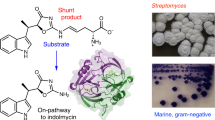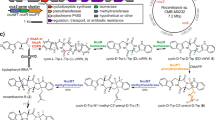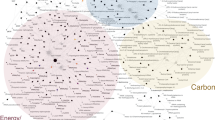Abstract
Uncultivated bacteria represent a massive resource of new enzymes and bioactive metabolites, but such bacteria remain functionally enigmatic. Polytheonamides are potent peptide cytotoxins produced by uncultivated bacteria that exist as symbionts in a marine sponge. Outside glycobiology, polytheonamides represent the most heavily post-translationally modified biomolecules that are derived from amino acids. The biosynthesis of polytheonamides involves up to 50 site-specific modifications to create a membrane-spanning β-helical structure. Here, we provide functional evidence that only seven enzymes are necessary for this process. They iteratively catalyse epimerization, methylation and hydroxylation of diverse amino acids. To reconstitute C-methylation, we employed the rarely used heterologous host Rhizobium leguminosarum to invoke the activities of two cobalamin-dependent C-methyltransferases. We observed 44 of the modifications to systematically unravel the biosynthesis of one of the most densely modified and metabolically obscure ribosome-derived molecules found in nature.
This is a preview of subscription content, access via your institution
Access options
Subscribe to this journal
Receive 12 print issues and online access
$259.00 per year
only $21.58 per issue
Buy this article
- Purchase on Springer Link
- Instant access to full article PDF
Prices may be subject to local taxes which are calculated during checkout






Similar content being viewed by others
Accession codes
References
Ryšlavá, H., Doubnerová, V., Kavan, D. & Vaněk, O. Effect of posttranslational modifications on enzyme function and assembly. J. Proteomics 92, 80–109 (2013).
Pisithkul, T., Patel, N. M. & Amador-Noguez, D. Post-translational modifications as key regulators of bacterial metabolic fluxes. Curr. Opin. Microbiol. 24, 29–37 (2015).
Arnison, P. G. et al. Ribosomally synthesized and post-translationally modified peptide natural products: overview and recommendations for a universal nomenclature. Nat. Prod. Rep. 30, 108–160 (2013).
Donia, M. S. et al. A systematic analysis of biosynthetic gene clusters in the human microbiome reveals a common family of antibiotics. Cell 158, 1402–1414 (2014).
Freeman, M. F. et al. Metagenome mining reveals polytheonamides as posttranslationally modified ribosomal peptides. Science 338, 387–390 (2012).
Hamada, T., Sugawara, T., Matsunaga, S. & Fusetani, N. Polytheonamides, unprecedented highly cytotoxic polypeptides, from the marine sponge Theonella swinhoei: 1. Isolation and component amino acids. Tetrahedron Lett. 35, 719–720 (1994).
Wilson, M. C. et al. An environmental bacterial taxon with a large and distinct metabolic repertoire. Nature 506, 58–62 (2014).
Demain, A. L. Antibiotics: natural products essential to human health. Med. Res. Rev. 29, 821–842 (2009).
Lewis, K. Platforms for antibiotic discovery. Nat. Rev. Drug Discov. 12, 371–387 (2013).
Shinohara, N., Itoh, H., Matsuoka, S. & Inoue, M. Selective modification of the N-terminal structure of polytheonamide B significantly changes its cytotoxicity and activity as an ion channel. ChemMedChem 7, 1770–1773 (2012).
Chatterjee, C., Paul, M., Xie, L. & van der Donk, W. A. Biosynthesis and mode of action of lantibiotics. Chem. Rev. 105, 633–684 (2005).
Tang, W. et al. Applications of the class II lanthipeptide protease LicP for sequence-specific, traceless peptide bond cleavage. Chem. Sci. 6, 6270–6279 (2015).
Rawlings, N. D. & Barrett, A. J. in Handbook of Proteolytic Enzymes 308, 1743–1773 (Elsevier, 2013).
Völler, G. H., Krawczyk, B., Ensle, P. & Süssmuth, R. D. Involvement and unusual substrate specificity of a prolyl oligopeptidase in class III lanthipeptide maturation. J. Am. Chem. Soc. 135, 7426–7429 (2013).
Ortega, M. A. et al. Substrate specificity of the lanthipeptide peptidase ElxP and the oxidoreductase ElxO. ACS Chem. Biol. 9, 1718–1725 (2014).
Siezen, R. J. & Leunissen, J. A. M. Subtilases: the superfamily of subtilisin-like serine proteases. Protein Sci. 6, 501–523 (2008).
Brömme, D., Peters, K., Fink, S. & Fittkau, S. Enzyme–substrate interactions in the hydrolysis of peptide substrates by thermitase, subtilisin BPN′, and proteinase K. Arch. Biochem. Biophys. 244, 439–446 (1986).
Morinaka, B. I. et al. Radical S-adenosyl methionine epimerases: regioselective introduction of diverse D-amino acid patterns into peptide natural products. Angew. Chem. Int. Ed. 53, 8503–8507 (2014).
Bode, H. B. et al. Determination of the absolute configuration of peptide natural products by using stable isotope labeling and mass spectrometry. Chem. Eur. J. 18, 2342–2348 (2012).
Cox, J. & Mann, M. Maxquant enables high peptide identification rates, individualized p.p.b.-range mass accuracies and proteome-wide protein quantification. Nat. Biotechnol. 26, 1367–1372 (2008).
Krawczyk, B., Ensle, P., Müller, W. M. & Süssmuth, R. D. Deuterium labeled peptides give insights into the directionality of class III lantibiotic synthetase LabKC. J. Am. Chem. Soc. 134, 9922–9925 (2012).
Melby, J. O., Dunbar, K. L., Trinh, N. Q. & Mitchell, D. A. Selectivity, directionality, and promiscuity in peptide processing from a Bacillus sp. Al Hakam cyclodehydratase. J. Am. Chem. Soc. 134, 5309–5316 (2012).
Thibodeaux, C. J., Wagoner, J., Yu, Y. & van der Donk, W. A. Leader peptide establishes dehydration order, promotes efficiency, and ensures fidelity during lacticin 481 biosynthesis. J. Am. Chem. Soc. 138, 6436–6444 (2016).
Skaugen, M. et al. In vivo conversion of L-serine to D-alanine in a ribosomally synthesized polypeptide. J. Biol. Chem. 269, 27183–27185 (1994).
Pauwels, K., Van Molle, I., Tommassen, J. & Van Gelder, P. Chaperoning anfinsen: the steric foldases. Mol. Microbiol. 64, 917–922 (2007).
Lando, D., Peet, D. J., Whelan, D. A., Gorman, J. J. & Whitelaw, M. L. Asparagine hydroxylation of the HIF transactivation domain: a hypoxic switch. Science 295, 858–861 (2002).
Yang, M. et al. Factor-inhibiting hypoxia-inducible factor (FIH) catalyses the post-translational hydroxylation of histidinyl residues within ankyrin repeat domains. FEBS J. 278, 1086–1097 (2011).
Zhang, Q., van der Donk, W. A. & Liu, W. Radical-mediated enzymatic methylation: a tale of two SAMs. Acc. Chem. Res. 45, 555–564 (2012).
Werner, W. J. et al. In vitro phosphinate methylation by PhpK from Kitasatospora phosalacinea. Biochemistry 50, 8986–8988 (2011).
Marous, D. R. et al. Consecutive radical S-adenosylmethionine methylations form the ethyl side chain in thienamycin biosynthesis. Proc. Natl. Acad. Sci. USA 112, 10354–10358 (2015).
Benjdia, A. et al. The thiostrepton A tryptophan methyltransferase TsrM catalyses a cob(II)alamin-dependent methyl transfer reaction. Nat. Commun. 6, 8377 (2015).
Kamigiri, K., Hidaka, T., Imai, S., Murakami, T. & Seto, H. Studies on the biosynthesis of bialaphos (SF-1293) 12. C-P bond formation mechanism of bialaphos: discovery of a P-methylation enzyme. J. Antibiot. (Tokyo) 45, 781–787 (1992).
Kim, S. Y. et al. Different biosynthetic pathways to fosfomycin in Pseudomonas syringae and Streptomyces species. Antimicrob. Agents Chemother. 56, 4175–4183 (2012).
van Rhijn, P. & Vanderleyden, J. The rhizobium–plant symbiosis. Microbiol. Rev. 59, 124–142 (1995).
Burton, M. O. & Lochhead, A. G. Production of vitamin B12 by Rhizobium species. Can. J. Bot. 30, 521–524 (1952).
Tett, A. J., Rudder, S. J., Bourdès, A., Karunakaran, R. & Poole, P. S. Regulatable vectors for environmental gene expression in alphaproteobacteria. Appl. Environ. Microbiol. 78, 7137–7140 (2012).
Quadri, L. E., Sello, J., Keating, T. A., Weinreb, P. H. & Walsh, C. T. Identification of a Mycobacterium tuberculosis gene cluster encoding the biosynthetic enzymes for assembly of the virulence-conferring siderophore mycobactin. Chem. Biol. 5, 631–645 (1998).
Koehnke, J. et al. Structural analysis of leader peptide binding enables leader-free cyanobactin processing. Nat. Chem. Biol. 11, 558–563 (2015).
Ortega, M. A. et al. Structure and mechanism of the tRNA-dependent lantibiotic dehydratase NisB. Nature 517, 509–512 (2014).
Burkhart, B. J., Hudson, G. A., Dunbar, K. L. & Mitchell, D. A. A prevalent peptide-binding domain guides ribosomal natural product biosynthesis. Nat. Chem. Biol. 11, 564–570 (2015).
Shieh, Y.-W. et al. Operon structure and cotranslational subunit association direct protein assembly in bacteria. Science 350, 678–680 (2015).
Lothrop, A. P., Torres, M. P. & Fuchs, S. M. Deciphering post-translational modification codes. FEBS Lett. 587, 1247–1257 (2013).
Morioka, T., Loik, N. D., Hipolito, C. J., Goto, Y. & Suga, H. Selection-based discovery of macrocyclic peptides for the next generation therapeutics. Curr. Opin. Chem. Biol. 26, 34–41 (2015).
Masepohl, B. et al. Functional analysis of the cysteine motifs in the ferredoxin-like protein FdxN of Rhizobium meliloti involved in symbiotic nitrogen fixation. Mol. Gen. Genet. 233, 33–41 (1992).
Hamada, T. et al. Solution structure of polytheonamide B, a highly cytotoxic nonribosomal polypeptide from marine sponge. J. Am. Chem. Soc. 132, 12941–12945 (2010).
Acknowledgements
The authors thank H.-M. Fischer and R. Ledermann for their rhizobia expertise and strains, P. Poole for Rlv3841, M. Frank and L. Arrigo for assistance with PoyI experiments, S. Matsunaga for a T. swinhoei sample, J. LaClair for discussions, and A. Vagstad and H.-M. Fischer for critical reading of the manuscript. This work was supported by the Swiss National Science Foundation (31003A_146992 and 205321_165695), the EU (SYNPEPTIDE) and the DFG (PI 430/9-1) (J.P.), the Human Frontier Science Program (M.F.F.), the Studienstiftung des deutschen Volkes (M.J.H.) and the Humboldt Foundation (B.I.M.).
Author information
Authors and Affiliations
Contributions
M.F.F., M.H. and A.B. performed all E. coli experiments. M.F.F. designed and performed all rhizobia experiments. M.F.F., M.H., A.B. and B.I.M. performed LC-MS experiments. M.F.F., M.H. and A.B. analysed MS data. J.P., M.F.F. and M.H. designed the studies and wrote the manuscript. All authors discussed the results and made comments on the manuscript.
Corresponding authors
Ethics declarations
Competing interests
The authors declare no competing financial interests.
Supplementary information
Supplementary information
Supplementary information (PDF 11732 kb)
Supplementary information
Supplementary data 1 and 2 (ZIP 148 kb)
Rights and permissions
About this article
Cite this article
Freeman, M., Helf, M., Bhushan, A. et al. Seven enzymes create extraordinary molecular complexity in an uncultivated bacterium. Nature Chem 9, 387–395 (2017). https://doi.org/10.1038/nchem.2666
Received:
Accepted:
Published:
Issue Date:
DOI: https://doi.org/10.1038/nchem.2666
This article is cited by
-
Structural and mechanistic basis for RiPP epimerization by a radical SAM enzyme
Nature Chemical Biology (2024)
-
Core-dependent post-translational modifications guide the biosynthesis of a new class of hypermodified peptides
Nature Communications (2023)
-
Mining genomes to illuminate the specialized chemistry of life
Nature Reviews Genetics (2021)
-
Minimal lactazole scaffold for in vitro thiopeptide bioengineering
Nature Communications (2020)
-
Highlights of marine natural products having parallel scaffolds found from marine-derived bacteria, sponges, and tunicates
The Journal of Antibiotics (2020)



